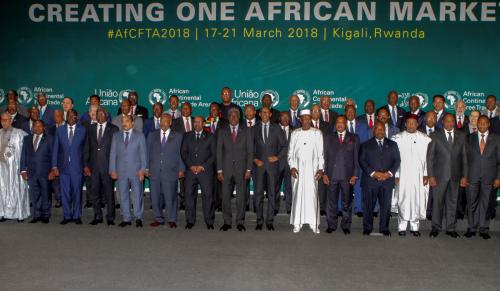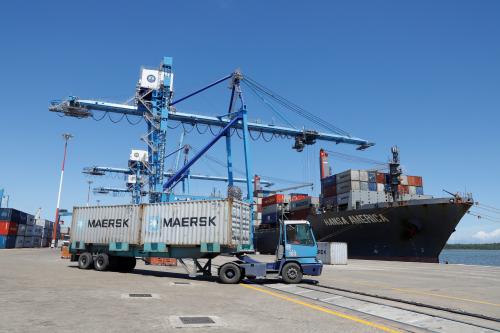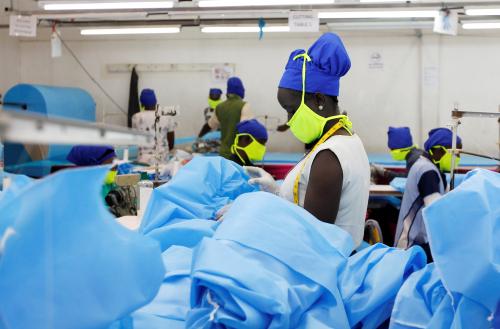The African Continental Free Trade Area (AfCFTA) presents a major opportunity for African countries to reduce poverty, boost incomes, accelerate growth, attract foreign direct investment, and diversify exports. In The African Continental Free Trade Area: Economic and Distributional Effects, the World Bank finds that the AfCFTA, if implemented fully, could boost regional income by $450 billion, bring 30 million people out of extreme poverty, and raise the incomes of 68 million others who live on less than $5.50 a day. The report also argues that the AfCFTA can, in the short term, mitigate some of the negative economic effects of the COVID-19 pandemic by supporting regional trade and value chains and, in the long term, provide a framework for increased cooperation, integration, and policy reform in Africa.
The effects of the AfCFTA, however, differ significantly by country and area of policy reform (Figure 1). The report estimates that the highest income gains will occur in Côte d’Ivoire, Zimbabwe, Kenya, and Namibia, which would see income gains of over 10 percent each by 2035. In contrast, countries such as Madagascar, Mozambique, and Malawi would see income gains of less than 3 percent. The authors note that gains are closely related to the initial level of trade barriers and costs, though the relationship is complex: Countries that already have few barriers to trade will tend to benefit more from improved market access but less from their own liberalization, while countries with heavily protected trade will face increased import competition but benefit more from lower imported input prices. Additionally, the largest income gains are expected to come from policies addressing non-tariff barriers (NTBs) rather than those addressing tariffs, as NTBs are generally more costly and restrictive to intra-African trade than tariffs.
Figure 1. Real income gains, by country and policy reform
Source: World Bank, The African Continental Free Trade Area: Economic and Distributional Effects, 2020
Note: NTBs = non-tariff barriers, TF = trade facilitation
Moreover, the report states that the AfCFTA is also expected to have a substantial positive impact on wages, with heterogeneity by region, skill level, and gender (Figure 2). While wages are expected to increase in every region, the gains are projected to be highest in North Africa and lowest in West Africa under full implementation of the AfCFTA. Furthermore, in North Africa, the World Bank projects that wage gains will be higher for skilled labor than unskilled labor. In contrast, in West, East, and Central Africa, wage gains are expected to be higher for unskilled labor. These effects on relative wages are primarily driven by changes in the composition of output—toward, for example, more labor-intensive industries in some regions, and more capital-intensive industries in others—induced by the AfCFTA.
Figure 2. Effects of AfCFTA on wages by skill level
Source: World Bank, The African Continental Free Trade Area: Economic and Distributional Effects, 2020
Similarly, Figure 3 breaks down expected wage gains by region and gender under full implementation of the AfCFTA, showing that wage gains are projected to be higher for women in all regions except Southern Africa. The report states that this trend is a result of the AfCFTA’s potential expansion of output in female labor-intensive industries. Overall, wages for women are projected to increase by 10.5 percent by 2035.
Figure 3. Effects of AfCFTA on wages by gender
Source: World Bank, The African Continental Free Trade Area: Economic and Distributional Effects, 2020
The report concludes by discussing several caveats to these results. The results may underestimate the impact of the AfCFTA because they do not include informal trade flows, dynamic gains from trade such as through productivity gains, or foreign direct investment. However, the results may also overestimate the impact of the AfCFTA because they do not capture the costs of lowering NTBs or the costs of trade-related structural change. In addition, the report argues that while the AfCFTA presents great opportunities, implementation will be a significant challenge. The report identifies NTBs as a priority for policymakers during implementation, as this is the area where the analysis predicts the largest potential economic gains.









Commentary
Figure of the week: The AfCFTA’s effects on trade and wages in Africa
September 2, 2020